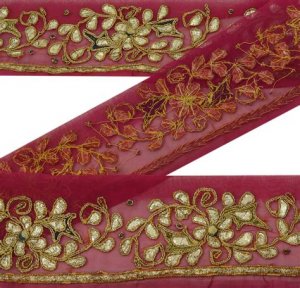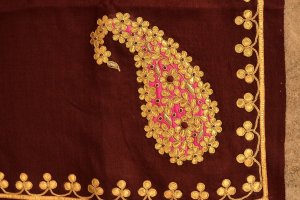Gota Patti Craft Rajasthan
Gota patti craft of Jaipur, a fabric ornamentation, is famously called Lappe ka kaam. Gota is an appliqué kind of work on the clothes. In this craft, the small pieces of zari or ribbons are stitched onto the fabric with edges sewn down to create exquisite patterns.
The effect of the gold zari work is given by the broad, golden ribbons which are sewn down at the edges. While zari is usually gold, zardozi embroidery is magnificently ornamental, densely enveloped in gold thread work.
It is practiced in Jaipur and a few other cities in India. To most foreigners – used to sleek, understated wear – the north Indian bride’s lehanga, choli and dupatta, heavily embroidered with gold and silver threads comes as a visual shock.
Zari threads are usually real silver, gold-plated or an imitation which has copper base gilded with gold and silver colour. Gota ribbons were woven with a wrap of flattened gold and silver wire and a weft of silk/cotton thread and used as functional and decorative trims for a variety of garments and textiles.
Traditionally Gota was only used by royalty, members of the court, temple priests, and idols, alongside for altering clothes at shrine and temple offerings.
Today Gota is used by all castes and communities, this was due to the consequent switch from gold and silver to gilt or lurex and when Surat and Ajmer started the mass production of Gota in electrically powered swivel looms.
Gota Patti Craft: electrically powered swivel looms

Traditionally and even today, Gota work worn on auspicious days is considered as a good will or good omen.
Gota may be used as kinari, edging, or cut and manipulated into motifs that are sewn onto garments and turbans worn during weddings and festivals.
It is worked with the appliqué technique using running, back, hem, or couching stitch on fabrics like georgette, chiffon, tussar silk, crepe, bandhani, cotton, viole, etc.
you can find it in various different colours like red, orange, pink, maroon and yellow. Motifs consist of peacock, sparrow, paisley, floral, geometrical, human figure, palanquin, elephant and horse.
These motifs are then organised into buta, buties, border or jal. As per Gota tukdi technique, Gota is first cut into various shapes- gamla (flower pot), kairi (mango) and champak flower. It is then appliquéd on the base fabric adorned with embroideries like zari and zardozi.
Gota Patti involves folding of tapes into Patti or leaves, which are basically rhomboid units. These Pattis are combined together and made into an ostentatious patterns for motifs that are later sewn on the turbans, garments, baskets, thalposh or platter covers and hookah.
The various products made are salwar kurta, lehenga, short kurtis, topper, skirts, cholis, ghagras, odhnis, saris, rakhi, turbans, torans, cushion cover, mobile cover and jooties.

While traditionally it was quite an exclusive luxury, today people who can afford it do buy it as a bridal wear and to wear it on auspicious occasions.
Obviously, no gold or silver thread is used today to create them. Today we have synthetic or tested zari embroidery. Metal ingots are melted and pressed through perforated steel sheets, to be converted into wires.
They are then hammered to the required thinness. Plain wire is called badla, and when wound round a thread, it is called kasav. Smaller spangles are called Sitara, and tiny dots made of badla are called mukaish.
Gota work is basically a gold cloth fabric sewn over other fabrics to create a motif or design. And kinari is the outlying border decoration.
The art is practiced primarily by Muslim craftsmen. Zardozi, a more elaborate version of zari, involves the use of gold threads, spangles, beads, seed pearls, wire, Gota and kinari.
Zardozi work makes a garment quite heavy so do try it on before buying. Besides, the metal thread work can make your skin feel itchy, see if you can handle that.


